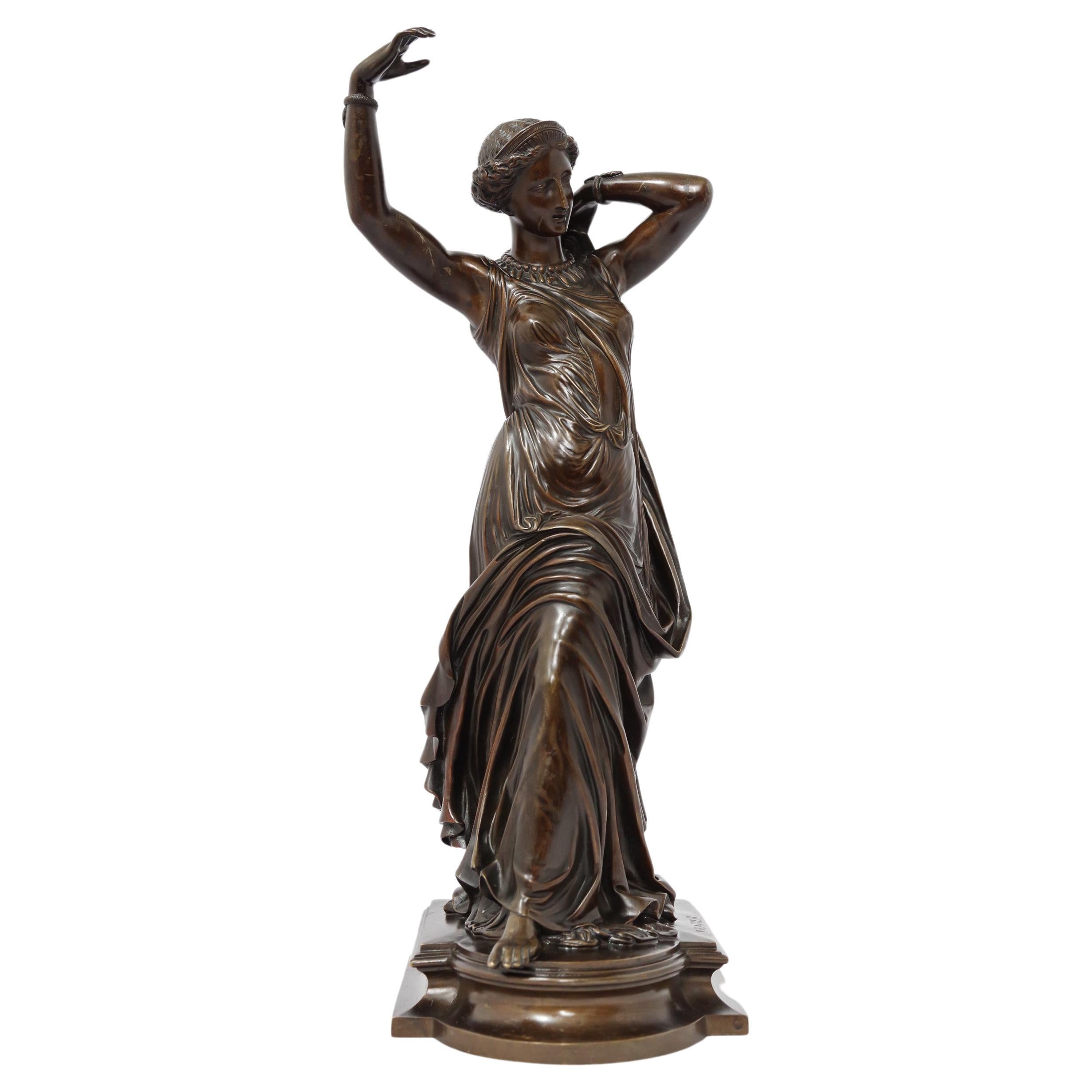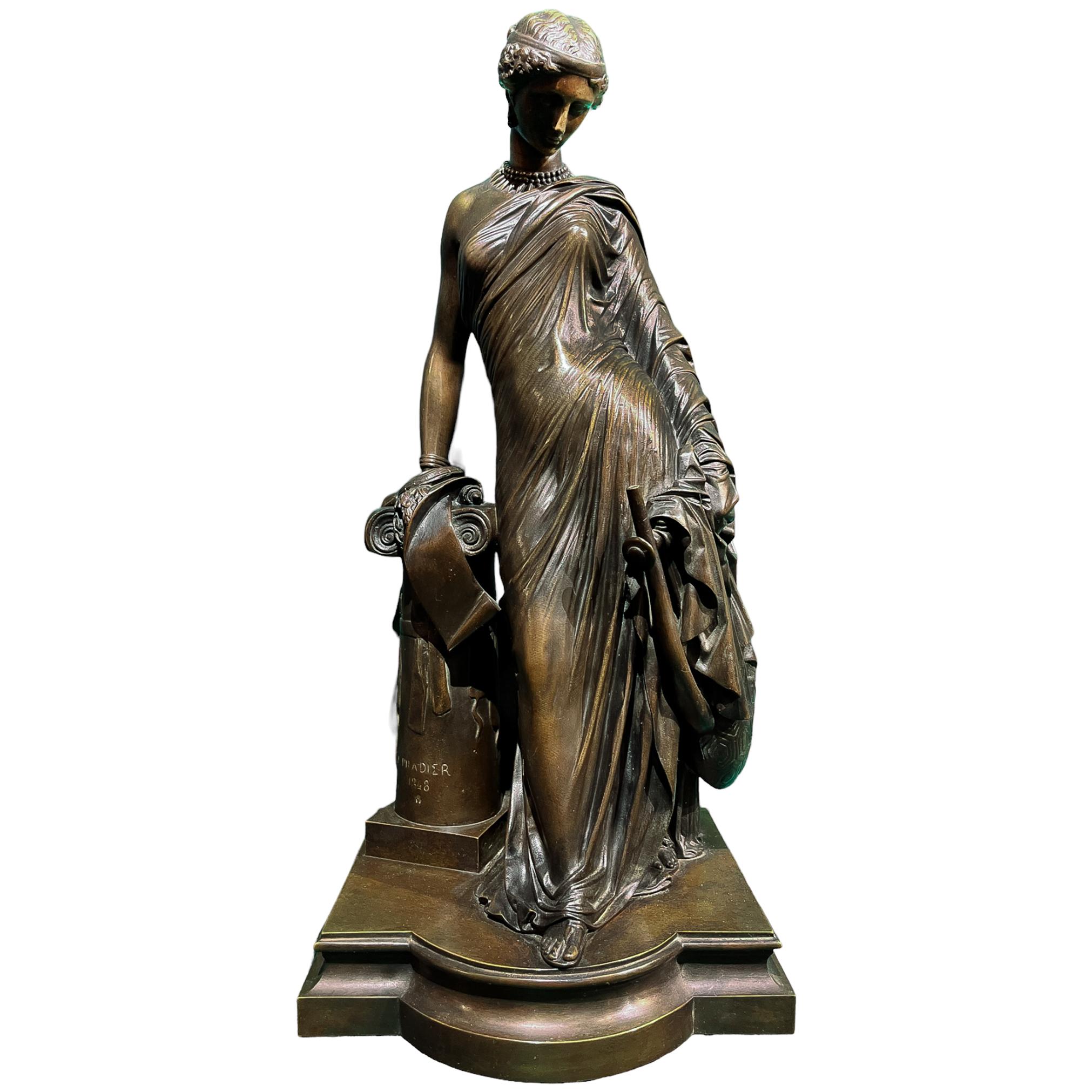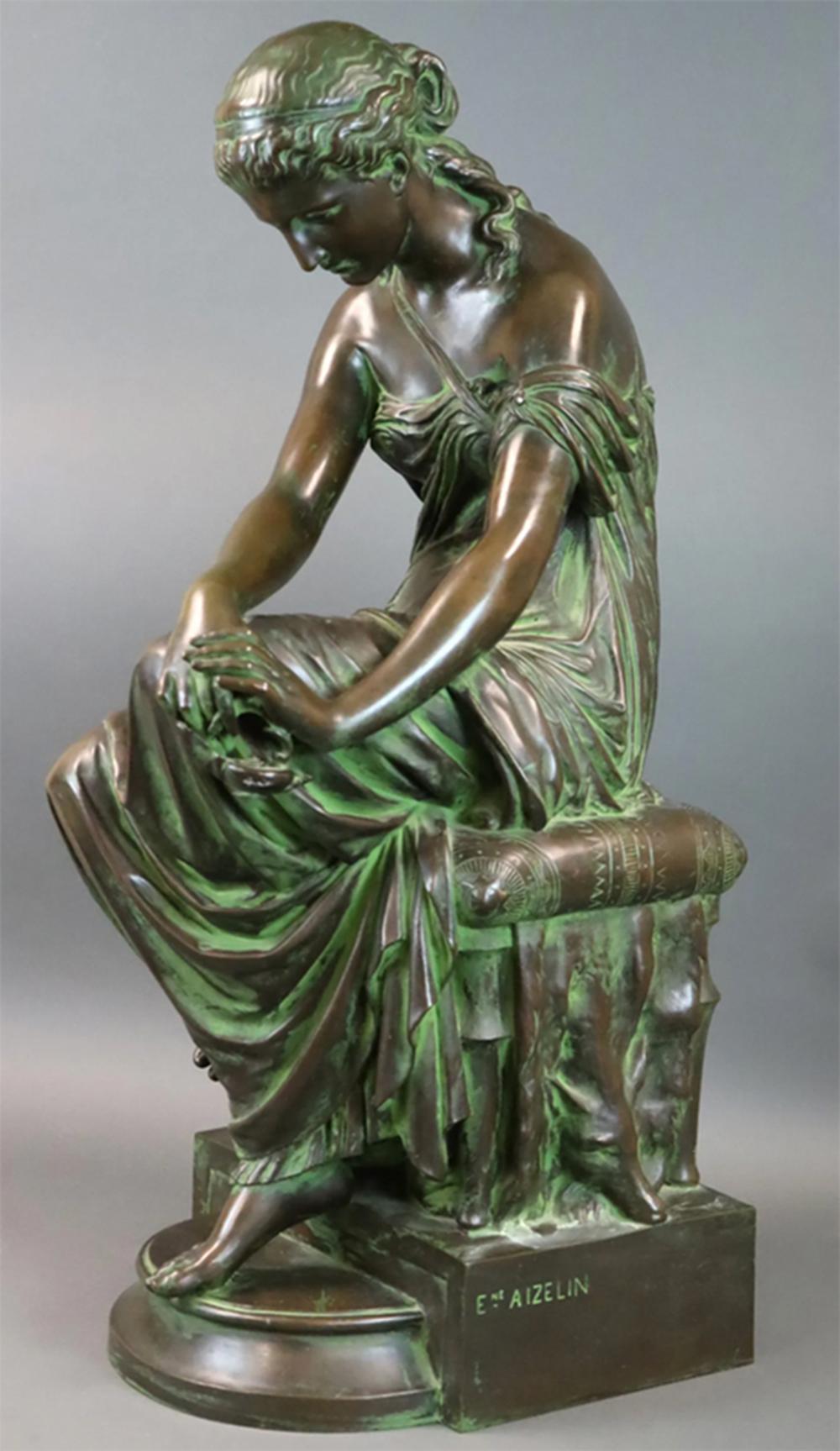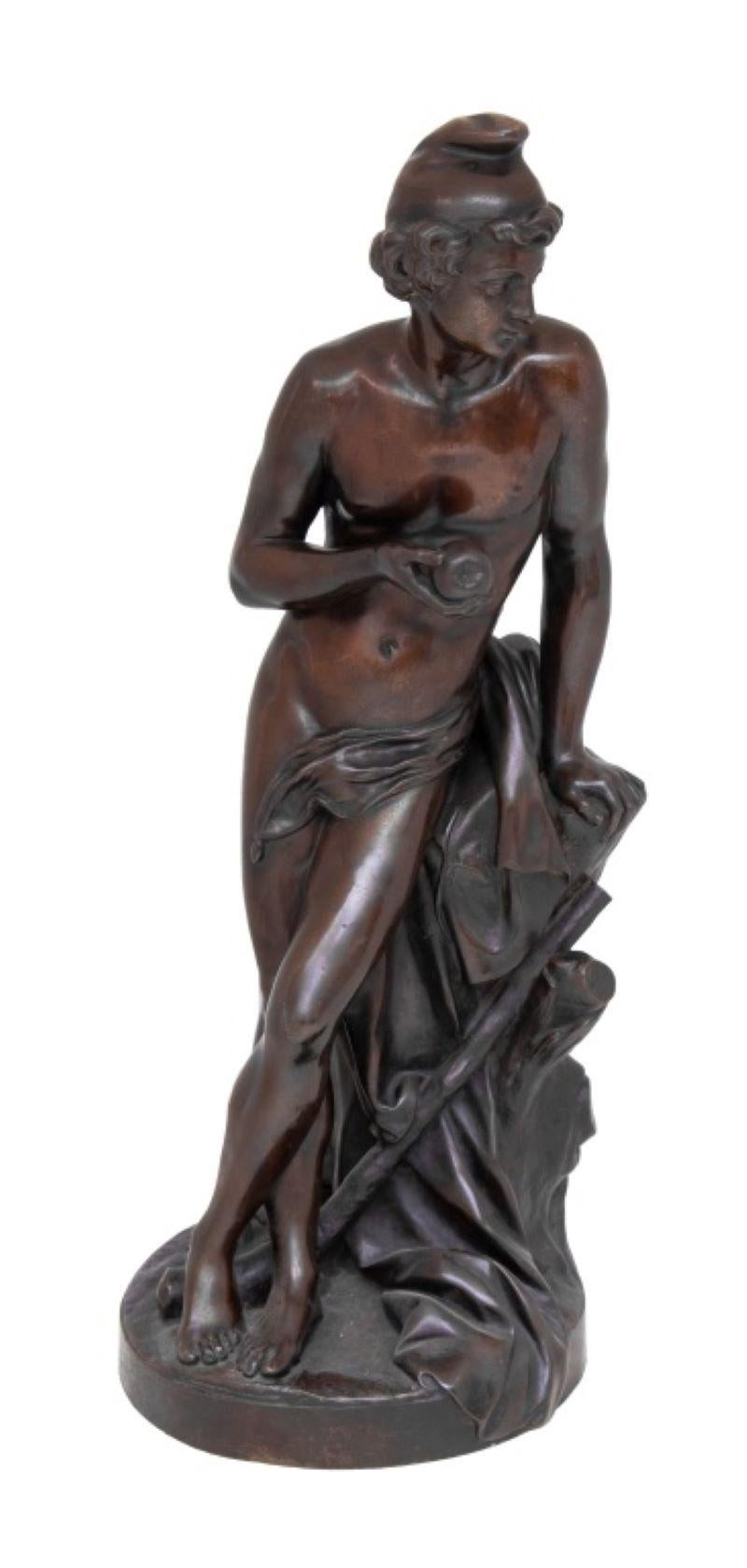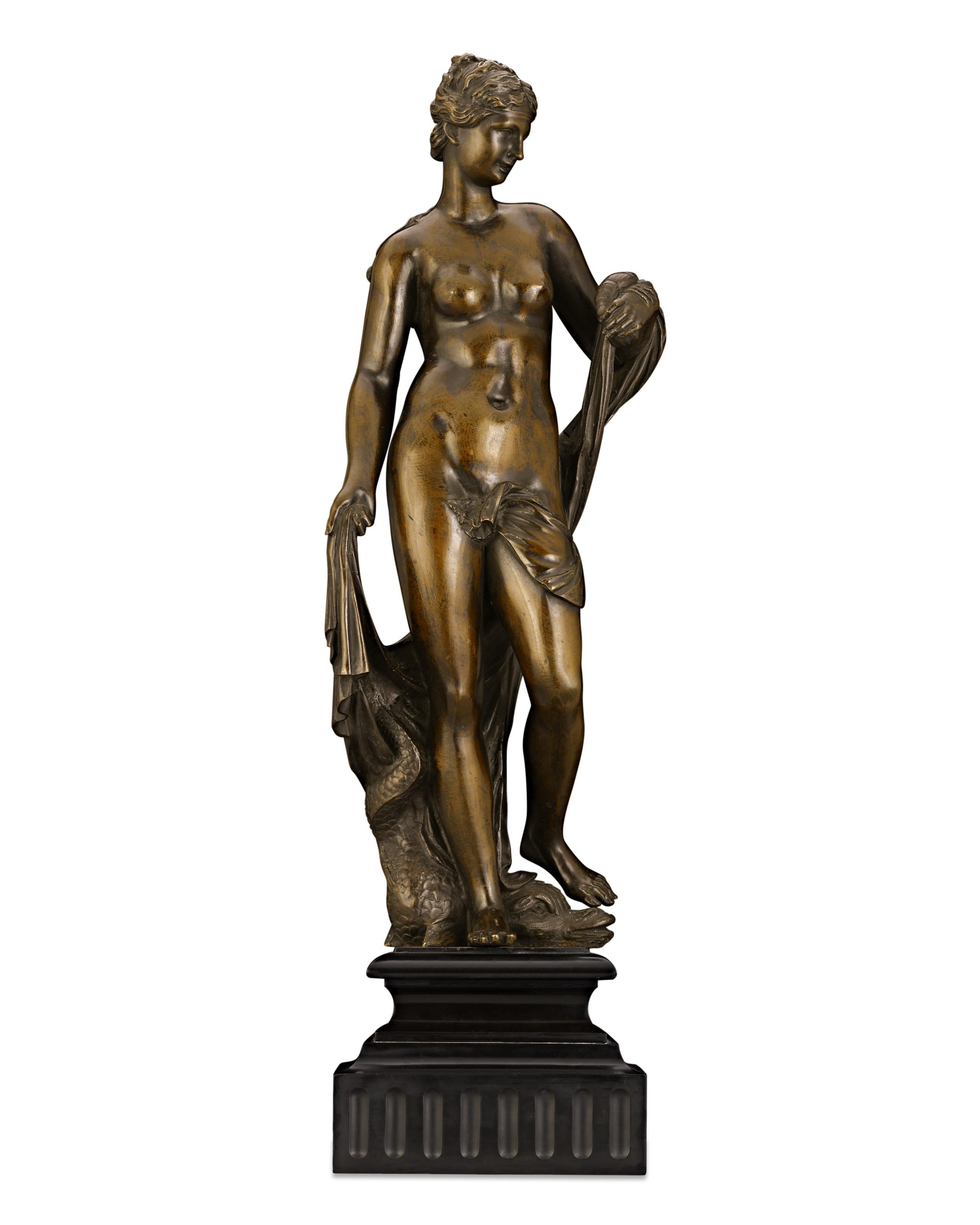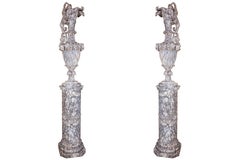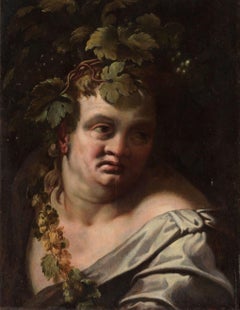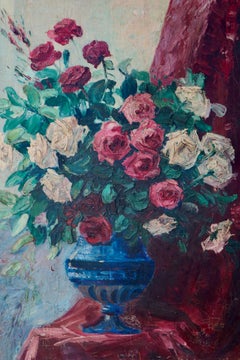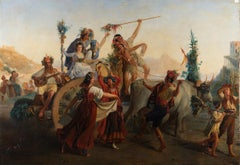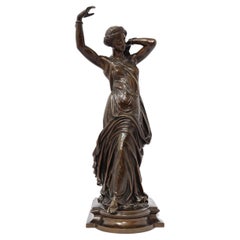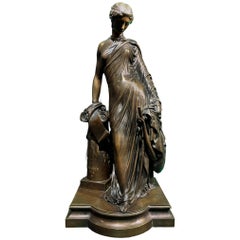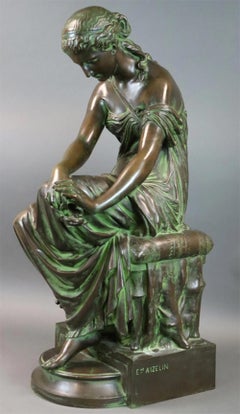Articoli simili a James Pradier, Phryne
Caricamento del video
Vuoi altre immagini o video?
Richiedi altre immagini o video al venditore
1 di 9
James PradierJames Pradier, Phryne1820-40
1820-40
6500 €IVA inclusa
Informazioni sull’articolo
Phryne di James Pradier 1790-1852
Bellissimo bronzo raffigurante "Phryne" una graziosa cortigiana dell'antica Grecia ricoperta dal suo peplo.
Timbro Susse Frères, firmato sulla terrazza "Pradier".
Frine (circa 371 a.C. - dopo il 316 a.C.) era un'antica hetaira (cortigiana) greca. From Thespiae in Boeotia, she was active in Athens, where she became one of the wealthiest women in Greece. She is best known for her trial for impiety, where she was defended by the orator Hypereides. According to legend, she was acquitted after baring her breasts to the jury, though the historical accuracy of this episode is doubtful. She also modeled for the artists Apelles and Praxiteles, and the Aphrodite of Knidos was based on her.
James Pradier, nato il 23 maggio 1792 a Ginevra, morto il 4 giugno 1852 a Rueil, vicino a Parigi. Younger brother of engraver Charles-Simon P., James P. is the best known representative of French sculpture from the period of the bourgeois monarchy. He received his first education in Geneva from the sculptor Jean Jaquet, then entered in 1809 as a student in the Lemot studio in Paris, took French citizenship, obtained in 1813 the grand prize of the School of Fine Arts and then stayed in Rome until 1819. Tornò a Parigi ed espose con successo ai Salon; nel 1824 fu decorato con la Legione d'Onore e nel 1827 fu nominato membro dell'Institut e professore della Scuola di Belle Arti. His most famous works are the muliebri figures, of monumental proportions, in the Place de la Concorde in Paris, the twelve Victories on the tomb of Napoleon I to the Invalids, two statues in the Chamber of Deputies (1832)the plastic decoration of the tympanum in the triumphal arch of the Étoile (1833), the fountain Molière (1842) in Richelieu street; in Geneva the bronze statue of Rousseau, as well as the excellent terracotta sketches in the museum.
- Creatore:James Pradier (1790 - 1852)
- Anno di creazione:1820-40
- Dimensioni:Altezza: 42 cm (16,54 in)Larghezza: 15 cm (5,91 in)Profondità: 15 cm (5,91 in)
- Tecnica:
- Movimento e stile:
- Periodo:1820-1829
- Condizioni:
- Località della galleria:Tricase, IT
- Numero di riferimento:1stDibs: LU2645213122972
Informazioni sul venditore
5,0
Venditore professionale selezionato
Ogni venditore supera rigorosi standard di autenticità e affidabilità
Fondazione nel 1970
Venditore 1stDibs dal 2023
- SpedizioneRecupero del preventivo…Spedizione da: Tricase, Italia
- Politica di reso
Alcune parti di questa pagina sono state tradotte automaticamente. 1stDibs non può garantire che le traduzioni siano corrette. L’inglese è la lingua predefinita del sito.
Garanzia di autenticità
Nell’improbabile caso in cui si verifichi un problema con l’autenticità di un articolo, contattaci entro un anno per ottenere un rimborso completo. DettagliGaranzia di rimborso
Se il tuo articolo non corrisponde alla descrizione, è danneggiato durante il trasporto o non arriva, contattaci entro 7 giorni per un rimborso completo. DettagliAnnullamento entro 24 ore
Hai un periodo di tolleranza di 24 ore per annullare il tuo acquisto, senza necessità di fornire spiegazioni.Venditori professionali selezionati
I nostri venditori di livello internazionale devono aderire a rigorosi standard di servizio e qualità, garantendo l’integrità delle inserzioni.Garanzia miglior prezzo
Se scopri che un venditore ha pubblicato altrove lo stesso articolo a un prezzo più basso, applicheremo lo stesso prezzo.Consegna globale affidabile
La nostra rete di vettori leader del settore offre opzioni di spedizione specializzate in tutto il mondo, inclusa la consegna personalizzata.Altro da questo venditore
Mostra tuttoItalian school of the 20th century, alabaster columns
Italian school of the 20th century, Alabaster Columns
Spectacular baroque alabaster columns probably from the Tuscan school. The ancient and completely hand-sculpted works are perfec...
Categoria
Early 1900s, Altra arte
Materiali
Alabastro
Abraham Bloemaert, Bacco
Di Abraham Bloemaert
ATTRIBUTED TO ABRAHAM BLOEMAERT - GORINCHEM, 1564 - 1651, UTRECHT
Bacco olio su pannello 60 x 45 cm.
Abraham Bloemaert is a Dutch Golden Age artist, born in Gorinchem in 1564, initi...
Categoria
1610s, Barocco, Dipinti figurativi
Materiali
Oil, Tavola
Scuola impressionista francese, Natura morta con fiori
Pittore francese post-impressionista
still life with flowers, oil on canvas 120x90 cm.
Provenance: Parisian private collection
The proposed painting represents a proud example of F...
Categoria
Early 20th Century, Postimpressionismo, Dipinti (natura morta)
Materiali
Tela, Oil
ATELIER DI LOUIS LEOPOLD ROBERT, Le retour de la fête de la Madone de l'Arc
Di Louis Leopold Robert
ATELIER DI LOUIS LEOPOLD ROBERT
(La Chaux-de-Fonds, 13 maggio 1794 - Venezia, 20 marzo 1835)
Le retour de la fête de la Madone de l'Arc, près de Naples, olio su tela 140 x 100 cm.
...
Categoria
Anni 1820, Romantico, Dipinti figurativi
Materiali
Tela, Olio
Neapolitan caravagist artist, 17th century SAINT THOMAS APOSTOLE
Di Hendrick de Somer
Neapolitan caravagist artist, 17th century
SAINT THOMAS APOSTOLE
oil on canvas, cm 127x101
(The painting is part of a triptych together with the two holy apostles Saint James the Mi...
Categoria
1620s, Barocco, Dipinti figurativi
Materiali
Tela, Oil
English Native School, 19th Century, still life with fish
English Native School, 19th Century, still life with fish
Olio on canvas 54x63 cm frame included.
Beautiful native English painting, representing an elegant still life of fish, cabb...
Categoria
1880s, Scuola inglese, Dipinti (natura morta)
Materiali
Tela, Oil
Ti potrebbe interessare anche
Scultura in bronzo Odalisca patinata in mogano di Pradier
Di J. Pradier
Un bronzo patinato color mogano/cioccolato scuro di una delle migliori fonderie del XIX secolo, Siot-Decauville. Lo scultore James Pradier (1790-1852), che iniziò la sua carriera con...
Categoria
Di antiquariato/d’epoca, XIX secolo, Francese, Romantico, Sculture figur...
Materiali
Bronzo
2040 € Prezzo promozionale
20% in meno
Saffo appoggiata a una colonna con la lira di Pradier in bronzo francese
Bronzo francese raffigurante Saffo appoggiata a una colonna con in mano la sua lira di tartaruga, patina marrone originale intatta.
Artista: Jean Jacques Pradier (Svizzera 1790-185...
Categoria
Metà XIX secolo, Sculture figurative
Materiali
Bronzo
Donna che si toglie la camicia
Donna che si toglie la camicia
di James Pradier (1790-1852)
Bronzo con patina marrone sfumata
cast di SOYER e INGE
Francia
1850 circa
altezza 28,5 cm
Biografia :
Jean-Jacques Prad...
Categoria
Anni 1850, Scuola francese, Sculture (nudo)
Materiali
Bronzo
Eugene-Antoine Aizelin (francese, 1821-1902) Bronzo patinato di Psiche
Di Eugene-Antoine Aizelin
This fabulous figural bronze statue of Psyche by the Barbedienne Foundry is simply exquisite. Remnants of a lovely green oxidation, nestled within the corners, curves and crevices of...
Categoria
XIX secolo, Accademia, Sculture figurative
Materiali
Bronzo
Scultura in bronzo Émile Louis Picault
Di Émile Louis Picault
Emile Louis Picault (francese, 1833-1915) Scultura in bronzo patinato "Parigi", fine del XIX secolo, figura in piedi che regge una mela d'oro, firmata alla base. H. 32" x L. 12" x P....
Categoria
Fine XIX secolo, Art Nouveau, Sculture figurative
Materiali
Bronzo
Bronzo di Anfitrite dopo Michel Anguier
Dopo Michel Anguier
Francese 1612-1686
Anfitrite
Bronzo
Questo straordinario capolavoro in bronzo è stato fuso sulla base di un'opera dell'Alto Barocco dello scultore francese Mic...
Categoria
XVII secolo, Barocco, Sculture (nudo)
Materiali
Bronzo
